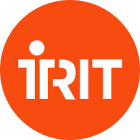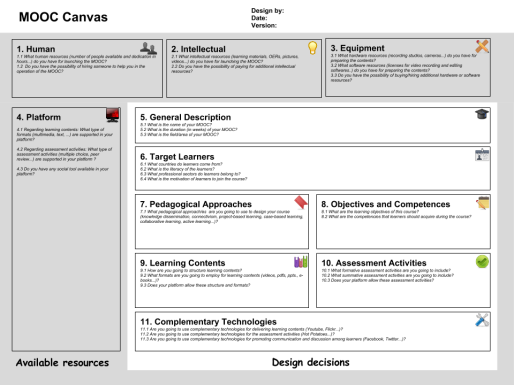The MOOC canvas is a conceptual framework for supporting educators in the description and design of MOOCs from scratch. The MOOC Canvas defines eleven interrelated issues that are addressed through a set of questions, offering a visual and understandable guidance for educators during the MOOC design process.
About the MOOC Canvas Project
Authors: The MOOC Canvas Project is a proposal of the Gradient Lab of the Universidad Carlos III de Madrid, coordinated by the Dr. Carlos Alario-Hoyos, Mar Pérez-Sanagustín, Carlos Delgado Kloos, Dave Cormier as collaborators.
Aim: Support teachers and other stakeholders in the design of a MOOC from scratch.
Webpage (under construction): http://mooccanvas.com/
Download the MOOC Canvas HERE! And start planning your MOOCs
Related references
- Alario-Hoyos, C.; Pérez-Sanagustín, M.; Cormier, D.; Delgado Kloos, C.: Proposal for a conceptual framework for educators to describe and design MOOCs. Journal of Universal Computer Science (JUCS), Special issue on Interaction in Massive Courses, 20(1), pp. 6-23 (paper)
- Alario-Hoyos, C., Pérez-Sanagustín, M., Delgado Kloos, C., Gutiérrez-Rojas, I., Leony, D., Parada G. H.A., Designing your first MOOC from scratch: recommendations after teaching “Digital Education of the Future”, eLearning papers, From the field, 37(3), 1-7, March 2014. (Paper)
- Alario-Hoyos, C., Pérez-Sanagustín, M., Delgado Kloos, C.: Are we all on the same Boat? Coordinating Stakeholders for the Design of MOOCs, EC-TEL Conference 2014 (In press)
What is the MOOC Canvas
The MOOC Canvas is a simple and visual framework for educators that need to design a MOOC from scratch. The MOOC Canvas is inspired by the ideas and structure of the Business Model Canvas by Osterwalder and Pigneur (2010), but gathering the main issues of logistical, technological, pedagogical and financial nature that educators need to think of during the design of a MOOC.
Issues and key questions
The MOOC Canvas is composed by 11 related issues organized into two categories: available resources and design decisions. Each of the eleven issues is addressed through a set of key questions (See Table 1) that invite the teaching staff to reflect and discuss about the issue, guiding them in the overall description and design of the MOOC .
Available Resources
| Issues in the Available Resources category | Key Questions | Affected issues |
| 1. Human | (1.1) What human resources (number of people available and dedication in hours…) do you have for launching the MOOC?(1.2) Do you have the possibility of hiring someone else to help you in the operation of the MOOC? | 5, 7, 9, 10 and 11 |
| 2. Intellectual | (2.1) What intellectual resources (learning materials, OERs, pictures, videos…) do you have for launching the MOOC?(2.2) Do you have the possibility of paying for additional intellectual resources? | 5, 6 and 9 |
| 3. Equipment | (3.1) What hardware resources (recording studios, cameras…) do you have for preparing the contents?(3.2) What software resources (licenses for video recording and editing software…) do you have for preparing the contents?(3.3) Do you have the possibility of buying/hiring additional hardware or software resource? | 9 |
| 4. Platform | (4.1) Regarding learning contents: What types of formats (multimedia, text…) are supported in your platform?(4.2) Regarding assessment activities: What type of assessment activities (multiple choice, peer review…) are supported in your platform? (4.3) Do you have any social tool available in your platform? | 7, Strongly constrained:9, 10 and 11 |
Table extracted from Alario-Hoyos et al. (2012).
Design decisions
| Issues in the Design Decisions category | Key Questions | Affected issues |
| 5. General Description | (5.1) What is the name of your MOOC? (5.2) What is the duration (in weeks) of your MOOC? (5.3) What is the field/area of your MOOC? | 6, 7 and 8 |
| 6. Target Learners | (6.1) What countries do learners come from? (6.2) What is the literacy of learners? (6.3) What professional sectors do learners belong to? (6.4) What is the motivation of learners to join the course? | 7 and 8 |
| 7. Pedagogical Approaches | (7.1) What pedagogical approach/es and/or teaching methods are you going to use to design your course (knowledge dissemination, connectivism, project-based learning, case-based learning, collaborative learning, active learning…) | 8, 9, 10 and 11 |
| 8. Objectives and competences | (8.1) What are the learning objectives of the course? (8.2) What are the competencies that learners should acquire during the course? | 9 and 10 |
| 9. Learning Contents | (9.1) How are you going to structure learning contents? (9.2) What formats are you going to employ for learning contents (videos, pdfs, ppts, e-books…)? (9.3) Does your platform allow this structure and formats? | 11 |
| 10. Assessment Activities | (10.1) What formative assessment activities are you going to include? (10.2) What summative assessment activities are you going to include? (10.3) Does your platform allow these assessment activities? | 11 |
| 11. Complementary Technologies | (11.1) Are you going to use complementary technologies for delivering learning contents (YouTube, Flicker…)? (11.2) Are you going to use complementary technologies for the assessment activities (Hot Potatoes…)? (11.3) Are you going to use complementary technologies for promoting communication and discussion among learners (Facebook, Twitter…)? | – |
Table extracted from Alario-Hoyos et al. (2012).


